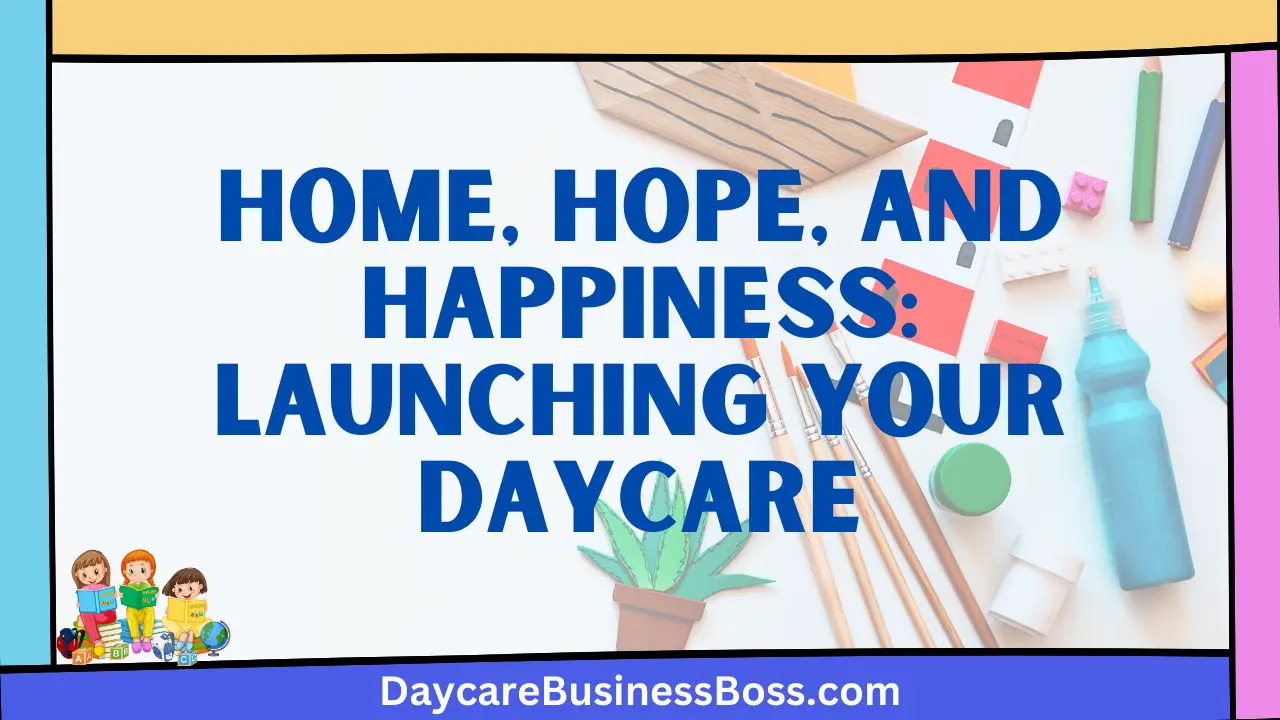The decision to create a daycare at home is more than just a commercial enterprise; it is a commitment to influencing the lives of young minds and creating a haven for children. This endeavor not only allows individuals to contribute to the community but also allows them to combine their enthusiasm for childcare with the comfort of their own homes.
To initiate a home daycare, you should begin by researching the regulations and requirements in your area. Design a secure and stimulating environment for children. Develop a well-structured daily program. Obtain the necessary licenses and permits, and effectively market your services to prospective parents.
This article will go over the numerous aspects of operating a home daycare. So come along with us as we explore the delights and complications of beginning a home daycare, where passion meets profession and the foundation for a brighter future is created in the comfort of our own homes.
Researching Regulations and Requirements: Building a Solid Foundation

Beginning the path of creating a home daycare enterprise involves much-preceding planning. At the forefront of this attempt is the critical responsibility of conducting an extensive study on the legislation and qualifications that apply in your unique geographic location. The childcare industry is tightly woven with a tapestry of rules, a landscape that might exhibit significant variances depending on your exact area. As a result, developing a clear understanding of the anticipated requirements becomes an essential first step.
The journey into regulatory complexities begins with proactive outreach to local authorities or the designated licensing agency. The goal of this outreach is to create a collection of information that covers a wide range of important topics. The canvas of zoning rules is crucial to this, as it defines the legal zones for running a daycare facility within residential areas. This early understanding is critical for the establishment’s survival and longevity, ensuring it blends in with the residential scene.
The pantheon of regulations places a premium on safety, which is a top priority in any childcare establishment. Investigating the safety requirements established by local authorities is essential for creating a supportive and secure environment for the children in your care. The acquisition of this knowledge has several dimensions, ranging from childproofing measures to fire safety practices.
The architecture of a home daycare business extends beyond physical infrastructure and into the core fabric of caregiving relationships. The critical criterion of staff-to-child ratios necessitates caution, with local legislation dictating the maximum number of children per caregiver. A thorough understanding of this aspect contributes to the development of a long-term model that prioritizes the well-being and tailored care of each kid.
These restrictions, like guiding stars, establish a course that can lead to a prosperous and legal business. This delicate dance with rules serves as the foundation for a facility that embodies obedience to the law, child safety, and quality care. Beyond legal compliance, this vigilance resonates with parents looking for a safe place for their children, establishing community trust and confidence.
Read more about: Opening a Special Needs Daycare Center: Providing Essential Care and Support
Creating a Secure and Stimulating Environment: Safety First
When establishing a home daycare, it is critical to provide a setting that is both safe and intellectually stimulating. The unshakable commitment to the safety and well-being of the children in your care is vital to this endeavor. Unquestionably, safety emerges as the guiding star for all decisions in this sphere. Beginning this process requires a thorough examination of your living area through the lens of childproofing. This complete examination is a proactive measure designed to discover potential hazards and precisely correct them. It’s a rigorous examination of everything from sharp corners to electrical outlets, ensuring that no danger goes overlooked.
Integrating safeguards into the environment becomes a critical component. The careful installation of safety gates functions as sentinels, defining off-limits zones and ensuring a safe play space. Unobtrusive outlet covers can prevent potentially fatal errors. Anchoring heavy furniture is similar to mooring a ship, protecting it from inadvertent tipping. These seemingly little precautions combine to provide a symphony of security that reverberates throughout the entirety of your daycare facility.
However, the objective goes beyond just safety. An important aspect is the formation of a vibrant and supportive environment that promotes intellectual progress. Imagination is at the heart of childhood, and investing in age-appropriate toys, books, and educational tools helps to fuel this domain. The shelves brimming with various books entice children to embark on excursions through words and realms. A treasure trove of toys caters to a wide range of interests while encouraging cognitive growth through play.
The careful layout of play and learning spaces is a critical component in this orchestration. These specified arenas act as stimuli for creativity and cognitive development. A colorful nook with craft tools becomes a haven for artistic expression. A pleasant corner surrounded by sofas and books turns into a literary wonderland. These spaces are more than just physical arrangements; they are havens for young brains to blossom, their natural curiosity fueled by an environment that encourages discovery.
Developing a Well-Structured Daily Program: Nurturing Growth and Learning
The creation of a properly structured daily program is the foundation of a thriving home daycare enterprise. Children, like perfectly tuned instruments, thrive when they can match the cadence of habit and consistency. Thus, creating a well-balanced timetable that effortlessly knits together a variety of activities that respond to the multifarious requirements of young brains is the blueprint for achievement.
The acknowledgment of children’s intrinsic penchant for routine is crucial to this orchestration. A well-structured day has the power to instill consistency in their world, anchoring their encounters in a soothing pattern. The piece begins with a delicate balance—a tapestry of playing, instructional interludes, shared meals, and necessary nap moments. This balance speaks to your grasp of the comprehensive requirements of each child in your care.
As a guiding principle, the vibrancy of customization arises. Recognizing diversity in your childcare, both in terms of age groups and individual preferences, is critical. The program is like a chameleon, changing colors to suit each child’s developmental stage and temperament. Every aspect of the day is carefully planned, from the cherubic infants who want gentle caressing to the lively toddlers who seek active interaction.
The essence of this daily symphony is the classic mix of instruction and fun. Incorporating learning into play and vice versa becomes an artistic alchemy for holistic development. The enchantment of arts and crafts that cultivate fine motor skills to the romance of storytime that kindles the embers of imagination are all part of the canvas of activities. Going outside, a dance of unrestricted freedom provides a conduit for physical development and social contact. Even basic exercises, no matter how unassuming they appear, promote cognitive activation.
This schedule’s scaffolding, on the other hand, is not inflexible. Flexibility, like a gentle breeze carrying seeds of spontaneity, plays a critical function. The program breathes and evolves in these interstices. Spontaneous activities flourish, guided by the ebbs and flows of the children’s interests. These amusing diversions are the conduits through which the curriculum bends, catering to the spontaneous evolution of each day and nourishing the distinct joys that each child brings.
Obtaining the Necessary Licenses and Permits: Legally Compliant Operation

Running a home daycare requires a painstaking trip through legal complexities, with adequate documentation serving as the anchor of legitimacy. This scenery is a diverse tapestry, varying depending on your geographical position. Thus, licenses, permits, and certifications verify your activity, paving the way to legal compliance. This intricate dance begins with a proactive dance of inquiry, contacting the local regulatory body to get insight into the precise requirements and the intricacies of the application procedure.
The canvas on which legal duties play out is broad and colorful, frequently encompassing a slew of prerequisites. The requirement for background checks, a thorough examination aimed at assuring the safety of the children in your care, is a common thread that runs through various countries. These checks serve as an affirmation, a tribute to your commitment to their well-being.
Health and safety inspections are written into the parameters of legal responsibility. These evaluations, undertaken with a critical eye, attest to your dedication to providing an atmosphere that meets the highest standards of care. The meticulous arrangement of these aspects serves as a cornerstone, an edifice in which parents can have complete faith.
CPR and first aid training, as embodiments of readiness, are universal prerequisites. These abilities, similar to those of guardian angels, can save lives. Equipping yourself with the means to respond quickly and effectively to emergent events is more than just a legal requirement; it promotes the cause of safety and well-being.
The concept of liability insurance develops as a safeguard against the unforeseeable in the mosaic of legal considerations. While not required in all jurisdictions, this protective shield provides a safety net around your business. Life’s unpredictability can bring up situations beyond your control, and liability insurance can provide peace of mind by protecting not only your business but also your assets.
Compliance with these legal duties is more than just a formality; it is the foundation upon which trust and credibility are built. Parents looking for a haven for their children gravitate toward places that exude dependability and obedience to the law. By navigating the maze of legal responsibilities, you ensure that your home daycare becomes more than just a location—it becomes a haven of security and trust.
Read more about: Home Daycare Kickoff: Understanding the Time Required for Home Daycare Setup
Effectively Marketing Your Services: Reaching Prospective Parents
Effective marketing emerges as a critical thread that knits together preparation in the intricate tapestry of developing a flourishing home daycare. As the curtains rise on this stage, it becomes clear that even the most precisely designed setting necessitates the use of a spotlight to truly shine. This spotlight is thrown through a planned approach of establishing a prominent and recognized presence in your community, attracting parents to your haven of childcare.
A digital presence is a bridge that connects the virtual world to the physical sanctuary you’ve established. The initial brushstroke in this artistic endeavor is to create a professional and inviting online persona. An attractively designed website becomes the foundation of your virtual domain, a blank canvas on which you may paint a vivid picture of the spirit of your daycare. Social media platforms serve as the brush and palette with which you paint your tale. Sharing engaging images of your daycare area, together with eloquent descriptions, piques interest. Highlighting the specific benefits of your program, as well as displaying testimonials from delighted parents, forms a chorus that resonates with sincerity.
Beyond the digital domain, the old-world allure of networking is priceless. This entails going beyond the screen and interacting with your community. Attending local parenting activities allows for face-to-face interactions. Online parenting groups help to transform virtual contacts into meaningful partnerships. Collaborations with child-focused enterprises create symbiotic ties that can foster reciprocal growth. These networks construct a picture in which your daycare is more than just a business—it’s an important part of the fabric of the community.
Word of mouth, a time-honored source of reputation, is still a powerful marketing technique. The experience you deliver is at the heart of this. Striving for quality in care, where children thrive and parents can relax, serves as the foundation for favorable recommendations. These compliments add up to a crescendo of trust that reverberates throughout the neighborhood, luring parents into your embrace.
Offering trial sessions or open houses goes beyond marketing; it’s an invitation into your universe. These experiences allow parents to enter the haven you’ve created and experience its nurturing embrace firsthand. This physical interaction provides individuals with the information they need to make an informed decision, building a bond that goes beyond simple service provision.
Flexibility is the final touch on this marketing canvas. Tailoring your approach to accommodate parents’ schedules and specific demands not only indicates your devotion but also sets you out from the crowd. This adaptability becomes the ribbon that binds the tapestry of trust you’ve created.
Frequently Asked Questions

What regulations must I follow when operating a home daycare?
Home childcare regulations differ by area. To learn about zoning regulations, safety standards, staff-to-child ratios, and other requirements, contact your local government or licensing agency. Compliance with these regulations is essential for a lawful and compliant operation.
How can I make my home daycare a stimulating atmosphere for children?
Create a safe environment by childproofing your house and eliminating any hazards. Invest in appropriate toys, books, and educational materials for the child’s age. Make separate locations for play and learning. To support holistic development, include a variety of activities such as arts & crafts, outdoor play, and storytime.
What steps should I take to properly advertise my home daycare?
Begin by creating your online presence with a website and social media networks. Display your daycare facility, emphasize program benefits, and include favorable testimonials. Attend parenting events and collaborate with local businesses to build your community network. Offering trial sessions and being accommodating to the demands of parents can also assist in attracting clients.
To learn more on how to start your own daycare checkout my startup documents here.
The information provided by DaycareBusinessBoss.com (“The Site”) is for general informational purposes only. All information on the Site is provided in good faith, however, we make no representation or warranty of any kind, express or implied, regarding the accuracy, adequacy, validity, reliability, availability or completeness of any information on the Site. Under no circumstance shall we have any liability to you for any loss or damage of any kind incurred as a result of the use of the Site or Reliance on any information provided on the Site. Your use of the Site and your reliance on any information on the Site is solely at your own risk.
This blog post is for educational purposes only and does not constitute legal advice. Please consult a legal expert to address your specific needs. Terms and Conditions. (https://daycarebusinessboss.com/terms-conditions/)

Meet Shawn Chun: Entrepreneur and Childcare Business Fan.
I’m a happy individual who happens to be an entrepreneur. I have owned several types of businesses in my life from a coffee shop to an import and export business to an online review business plus a few more and now I create online daycare business resources for those interested in starting new ventures. It’s demanding work but I love it. I do it for those passionate about their business and their goals. That’s why when I meet a childcare business owner, I see myself. I know how hard the struggle is to retain clients, find good employees and keep the business growing all while trying to stay competitive.
That’s why I created Daycare Business Boss: I want to help childcare business owners like you build a thriving business that brings you endless joy and supports your ideal lifestyle.

